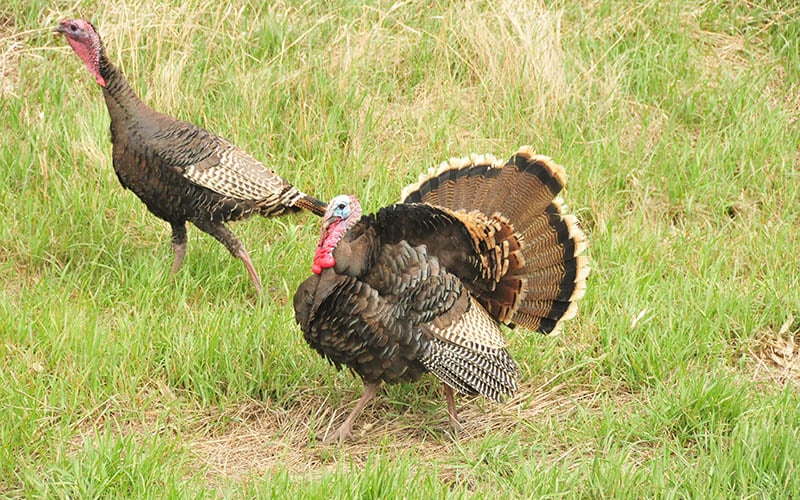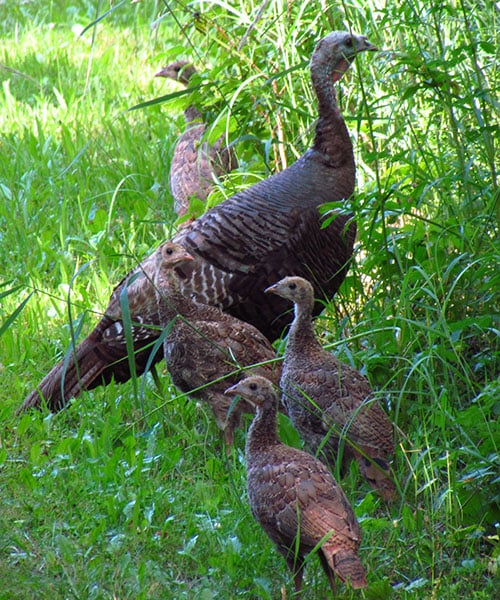
Last Updated on
It doesn’t get any better than watching a Merriam’s Turkey tom strut with the mountains and pine forest as a background. Get ready for an exciting challenge when hunting these beautiful birds!
Turkey hunting has been an important tradition in America for hundreds of years. Native Americans prized these birds for their meat, feathers and more. Today’s hunters can still enjoy the thrill of a wild turkey hunt while they try to bring home the ultimate trophy.
Merriam’s turkeys are, like their Eastern turkey cousins, quite intelligent and offer a challenging hunting experience. A large and well-seasoned tom can be one of the most difficult animals to hunt successfully. Although the Merriam’s turkey is not quite as common or wide-ranging as the Eastern turkey, it is still a very popular and interesting game bird.
Merriam’s Turkey History
When it comes to wild turkeys in North America, the Merriam’s turkey is a relatively new sub-species. Scientists believe that it evolved from domesticated Mexican or Gould’s turkeys by early North American natives in parts of Arizona and New Mexico.
In 1540, around two dozen Merriam’s turkeys were sent back to Spain as prizes from the new world for King Phillip’s court. Almost all domestic turkeys in Europe can be traced back to these two dozen birds. During the early 19th century in New Mexico, settlers in the area commonly made references to Merriam’s turkeys. They relied on these birds as an essential food source and noted their different colorations from other subspecies. By 1900, a naturalist named Dr. EW Nelson named the turkeys after Clinton Hart Merriam, the first chief of the United States Biological Survey.
Over the next few decades, over grazing and market hunting seriously reduced Merriam’s turkey populations. The New Mexico Game Department eventually stepped in to protect the birds and, since then, multiple reintroduction projects have been highly successful in restoring the population.
Current Status of Merriam’s Turkeys
The native range of the Merriam’s Turkey is considered to be Southern Colorado, Arizona and New Mexico. However, the turkeys have also been introduced to non-native areas including Washington, Oregon, California, Wyoming, Montana, Utah, South Dakota and Nebraska.
Today, New Mexico still has the largest and fastest-growing population of native Merriam’s turkeys. Both management and good weather have played a role in population growth over the past few years. Many states are now allowing licensed hunters to bag up to three Merriam’s turkeys every year now.
Physical Characteristics – Merriam’s Turkey
When it comes to pure size, the Merriam’s Turkey is very similar to the more wide-ranging Eastern Turkey. However, the Merriam’s coloration is quite different. They are darker in general with variations of black and iridescent bronzes, blues and purples. They can also be distinguished by the white feathers on their lower back and tail. These tail feathers really stand out as gobblers strut against a dark background.
Merriam’s Turkey toms tend to be darker in coloration than the hens. Females feature buff-colored breast feather tips while males have black-tipped feathers at the breast. Typically, hens also have lighter white wing feathers than toms. Although females do not have the growths and fleshy caruncles around their necks like the males, they do feature more colors on their heads than the hens of other subspecies.
Like the other North America turkey subspecies, Merriam’s Turkey males have red dewlaps, snoods and caruncles around their heads and necks. They also grow impressive beards and spurs on their legs as they age. Approximately ten percent of females do grow a beard, but it is much shorter than a typical male’s beard. Hens may also grow small, underdeveloped spurs.
Merriam’s Turkey Habitat
The Rocky Mountains are home for Merriam’s wild turkeys. Although they’ve been introduced in many other neighboring states along the West Coast and Great Plains, their historical range includes Colorado, New Mexico and the northern regions of Arizona.
The turkeys like to summer in higher elevations before moving to the foothills during the colder months. Depending on the weather conditions, Merriam’s turkeys can travel over 40 miles over a year’s time. The birds prefer habitats with abundant ponderosa pines and the pinyon-juniper woodlands, but when forced lower than the conifer line, they will live in cottonwood-filled habitats and scrounge for extra food closer to humans.
Merriam’s Turkey Behavior and Diet
Merriam’s Turkeys are not actually territorial. Instead they move across a large home range throughout the year. As the snow melts and the days get longer, the turkeys slowly move uphill to breed.
A powerful pecking order greatly influences the mating season for Merriam’s Turkeys. Toms gobble and strut both to attract hens and to intimidate other males. After mating, hens look for habitats with more dense vegetation to lay and incubate their eggs. The females will lay between 10 and 12 eggs during a two week laying period. Incubation typically takes between 26 and 28 days. Although they share similar habitats throughout the year, male and female Merriam’s turkeys are rarely seen together other than during the spring breeding season.
Merriam’s turkeys can have a very broad diet of different plants and insects. Their plant diet consists mostly of ponderosa pine seeds, chokecherries, bearberries, various grasses, vines and nuts. Although up to 90 percent of an adult turkey’s diet is plant-based, beetles, spiders and grasshoppers are usually their favorite insect snacks. Juveniles generally eat a much higher percentage of insects than adults. When forced into habitats with more humans, Merriam’s turkeys will eat grains like corn, rye, oats, barley and wheat.
Hunting the Merriam’s Turkey
Like all wild turkey subspecies, Merriam’s turkeys feature exceptional eyesight and impressive hearing. These characteristics make the elusive birds a true challenge for hunters. To have any consistent success, hunters must learn as much as possible about the turkeys and become very familiar with their different behaviors.
Calling may be the most important aspect of turkey hunting, and it is no different with Merriam’s. These turkeys make 28 different calls and each one has its own unique meaning. By knowing which one to use in a given situation, a hunter can lure a trophy into range.
Gear and Equipment for the Hunt
As mentioned above, calls are essential when hunting Merriam’s turkey. All turkey calls can be broken down into two base categories: friction calls and air calls. Friction calls include slate, push-button and box calls. They produce sound by forcing two surfaces to contact each other. Air calls or more like a wind instrument and include tube, wing-bone and mouth diaphragm calls. These calls require the hunter to blow through a chamber or across a diaphragm or reed. You will need to bring a wide variety of these calls every time you go on a turkey hunt.
Since Merriam’s turkeys have such good eyesight, camouflage clothing is also extremely important. Your clothing must protect you against the weather conditions and thick brush while also keeping you concealed throughout the hunt. A warm camouflage jacket, a sturdy pair of pants and comfortable hunting boots will go a long way, but if a gobbler can still see your hands and face, you won’t have much success. You should look into a good pair of gloves and a face mask for the best chances of bringing one home.
Decoys are another valuable part of turkey hunter’s gear list. Not only do decoys provide a visual lure to bring in the toms, but they also help keep their eyes off of you while you prepare to take a shot. Decoys cannot guarantee you a bird, but they certainly increase your odds. Just make sure it is legal to use decoys in your hunting area.
Even if you have the best camouflage in the world, a blind that blocks some of your movement can really help during a Merriam’s Turkey hunt. Remaining completely still while a tom moves closer is not always possible. You may have to quickly put your call down and pick up your shotgun, or you may need to shift your positioning when a tom comes in from a different angle than you were expecting. A blind can be even more valuable during afternoon and mid-day hunts when you may be sitting for a long time. The best turkey hunting blinds are portable, light, easy to set up and easy to take down
If you’re looking to hunt a surprisingly intelligent and challenging prey in a beautiful natural setting, the Merriam’s Turkey is a perfect choice. Do your research, get the right gear, and go enjoy the adventure!







Leave a Reply